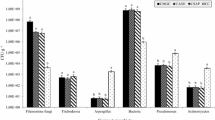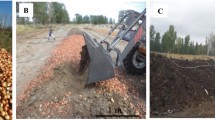Abstract
Compost produced from agricultural wastes can be used as the organic component of container media. We have studied the properties of composted grape marc (CGM) and composted separated cattle manure (CSM). Media amended with these composts were found to be suppressive to soilborne plant pathogens such asRhizoctonia solani andPythium aphanidermatum. Suppression is the result of microbial activity developing during the composting process. It is suggested that suppressive compost can be used in horticulture as a means of biological control.
Similar content being viewed by others
References
Chen, W.; Hoitink, H.A.J.; Madden, L.V. (1988) Microbial activity and biomass in container media for predicting suppressiveness of damping off caused byPythium ultimum.Phytopathology 78, 1447–1450.
Chen, Y.; Hadar, Y. (1987) Composting and the use of agricultural wastes in container media. In: Bertoldi, M., ľHermite, H.P. and Zucconi, F. [Eds.]Compost - Production, Quality and Use. Elsevier Applied Science, London, pp. 71–77.
Chen, Y.; Inbar, Y.; Hadar, Y. (1988) Composted agricultural wastes as potting media for ornamental plants.Soil Science 145, 298–303.
Daft, G.C.; Poole, H.A.; Hoitink, H.A.J. (1979) Composted hardwood bark: a substitute for steam sterilization and fungicide drenches for control of poinsettia crown and root rot.HortScience 14, 185–187.
Gorodecki, B.; Hadar, Y. (1990) Suppression ofRhizoctonia solani andSclerotium rolfsii in container media containing composted separated cattle manure and composted grape marc.Crop Protection 9, 271–274.
Hadar, Y.; Gorodecki, B. (1991) Suppression of germination of sclerotia ofSclerotium rolfsii in compost.Soil Biology and Biochemistry 23, 303–306.
Hadar, Y.; Mandelbaum, R. (1986) Suppression ofPythium aphanidermatum damping off in container media containing composted liquorice roots.Crop Protection 5, 88–92.
Hoitink, H.AJ. (1980) Composted bark, a lightweight medium with fungicidal properties.Plant Disease 64, 142–147.
Hoitink, H.A.J.; Fahy, P.C. (1986) Basis for the control of soilbome plant pathogens with composts.Annual Review of Phytopathology 24, 93–114.
Inbar, Y.; Chen, Y.; Hadar, Y. (1986) The use of composted cattle manure and grape marc as peat substitutes in horticulture.Acta Horticulturae 178, 147–154.
Inbar, Y.; Chen, Y.; Hadar, Y. (1991)Carbon-13 CPMAS NMR and FTIR spectroscopic analysis of organic matter transformations during composting of solid wastes from wineries.Soil Science 152, 272–282.
Inbar, Y.; Chen, Y.; Hadar, Y.; Hoitink, H.AJ. (1990) New approaches to compost maturity.BioCycle 31, 64–69.
Kuter, G.A.; Hoitink, H.A.J.; Chen, W. (1988) Effects of municipal sludge compost curing time on suppression ofPythium andRhizoctonia diseases of ornamental plants.Plant Disease 72, 731–756.
Lumsden, R.D.; Lewis, J.A.; Millner, P.D. (1983) Effects of composted sewage sludge on several soilborne pathogens and diseases.Phytopathology 73, 1543–1548.
Mandelbaum, R.; Hadar, Y. (1990) Effects of available carbon source on microbial activity and suppression ofPythium aphanidermatum in compost and peat container media.Phytopathology 80, 794–804.
Mandelbaum, R.; Hadar, Y.; Chen, Y. (1988) Compost of agricultural wastes for their use as container media. II. Effect of heat treatment on suppression ofPythium aphanidermatum and microbial activities in substrates containing compostBiological Wastes 26, 261–274.
Nelson, E.B.; Kuter, G.A.; Hoitink, H.A.J. (1983) Effect of fungal antagonists and compost age on suppression ofRhizoctonia damping off in container media amended with composted hardwood bark.Phytopathology 73, 1457–1462.
Author information
Authors and Affiliations
Rights and permissions
About this article
Cite this article
Hadar, Y., Mandelbaum, R. Suppressive compost for biocontrol of soilborne plant pathogens. Phytoparasitica 20 (Suppl 1), S113–S116 (1992). https://doi.org/10.1007/BF02980420
Issue Date:
DOI: https://doi.org/10.1007/BF02980420




